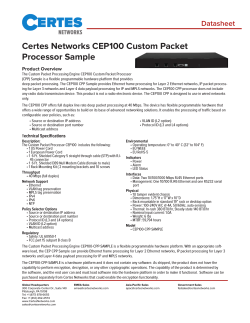
KeyStone I Network Coprocessor
TI Keystone Networking Coprocessor Introduction KeyStone Training Why Network Co Processor (NetCP): Motivation behind NETCP: • Use firmware based PDSP (Packet Descriptor Processors) to do processing and encryption. Goals for both Packet Accelerator and Security Accelerator: • Offload processing from the cores • Improve system integration • Allow cost savings at the system level Security Key applications: • IPSec tunnel endpoint (e.g. LTE eNB, ...) • Secure RTP (SRTP) • Air interface (2G/3G/4G) security processing Why Network Co Processor (NetCP) Generic Network Processing Keystone Network Processing with NetCP full offload Keystone Network Processing with NetCP Partial offload Agenda • KeyStone I/NetCP1.0 – Overview – Typical Application – PA 1.0 • KeyStone II/ NetCP1.5 – – – – Overview Typical Application PA 1.5 NetCP QMSS/PDSP Firmware/RA • NetCP 1.0 Vs NetCP1.5 • Security Accelerator – Overview – Channel Configuration – Data Process 4 KeyStone I Network Coprocessor Application-Specific Coprocessors Memory Subsystem DDR3 EMIF MSM SRAM MSMC C66x™ CorePac L1D L1P Cache/RAM Cache/RAM L2 Memory Cache/RAM TeraNet External Interfaces Switch Multicore Navigator Queue Packet Manager DMA Ethernet Switch HyperLink 1 to 8 Cores @ up to 1.25 GHz SGMII x2 Miscellaneous Security Accelerator Packet Accelerator Network Coprocessor • Provides hardware accelerators to perform L2, L3, and L4 processing and encryption that was previously done in software • Packet Accelerator (PA) • Single or multiple IP address option • UDP (and TCP) checksum and selected CRCs • L2/L3/L4 support • Quality of Service (QoS) • Multicast to multiple destinations inside the device • Timestamps • Security Accelerator (SA) • Hardware encryption, decryption, and authentication • Supports IPsec ESP, IPsec AH, SRTP, and 3GPP protocols 5 Packet Accelerator 1.0 Block Diagram L2 Classify Engine Pass 1 LUT 0 PDSP 0 PKTDMA Controller Timer 0 L3 Classify Engine 0 Pass 1 LUT 1 PDSP 1 SA Timer 1 L3 Classify Engine 1 Pass 1 LUT 2 SGMII0 SGMII1 GbE Switch Subsystem PHY mdio_link_intr[1:0] mdio_user_intr[1:0] misc_int stat_pend_raw[1:0] INTD Packet Streaming Switch • Provides hardware accelerators to perform the packet classification for Ethernet L2, L3, and L4 – Hardware Lookup table (LUT1 64 entry/table, LUT2 8K entry/table) • Based on use case firmware can be redefined/developed • Engines for modification (IP header/UDP header checksum, IP fragmentation, update PPPoE header) • Multi routing (same packet can be copied and routed to 8 different queue) PDSP 2 Timer 2 L4 Classify Engine Pass 2 LUT PDSP 3 Timer 3 Modify/Multi-Route Engine 0 PDSP 4 Timer 4 buf_starve_intr Modify/Multi-Route Engine 1 PDSP 5 Timer 5 NetCP1.0 Typical Application • Software for IP reasembly • Software IP Firewall • Software for Packet Framing on to-network direction Agenda • KeyStone I/NetCP1.0 – Overview – Typical Application – PA 1.0 • KeyStone II/ NetCP1.5 – – – – Overview Typical Application PA 1.5 NetCP QMSS/PDSP Firmware/RA • NetCP 1.0 Vs NetCP1.5 • Security Accelerator – Overview – Channel Configuration – Data Process 8 KeyStone II Network Coprocessor (NETCP) • Consists of one or two Network Coprocessor(s) • Provides hardware accelerators to perform L2, L3, and L4 processing and encryption that was previously done in software • Packet Accelerator (PA) – Single IP address option – UDP (and TCP) checksum and selected CRCs – L2/L3/L4 support – Quality of Service (QoS) – Multicast to multiple queues – Timestamps • Security Accelerator (SA) – Hardware encryption, decryption, and authentication – Supports IPsec ESP, IPsec AH, SRTP, and 3GPP protocols • 2x 5-port Ethernet switches (depending on number of instances of NETCP) with 4-8 ports connecting to 4-8 SGMII ports and one port connecting to the Packet and Security Accelerators. 9 Packet Accelerator 1.5 Block Diagram Packet Accelerator 1.5 • PA LLD interface and features are compatible with NetCP1.0 • Provides hardware accelerators to perform the packet classification for Ethernet L2, L3, and L4 – Hardware Lookup table (LUT1 256 entry/table, LUT2 3K entry/table) with mask/range configuration • Each PDSP can do more complex processing (MAX to 3K instructions) • Egress direction has capability to modify a packet as configuration and route it to Ethernet directly NetCP1.5 Typical Application • Hardware accelerators to do L2, L3, and L4 processing, packet classify • Hardware accelerators for IPSec/air cihper encryption • Hardware QoS for PQ/WRR • Hardware accelerators for IP reasembly • Hardware accelerators for Flow Cache • Hardware accelerators for IP Firewall NetCP QMSS • The primary use case is for handling CDMA based packet flows between PA and the Security Accelerator (SA) and Reassembly (RA) engines. • Using the PA1.5 queue management subsystem offloads DMA and queue operations from the global PA CDMA and chip-level QMSS. • Provides support for 128 total queues (2 Queue Managers supporting 64 queues each) • Supports up to 16K descriptors • Supports 16 memory regions for storage of descriptors with each region storing up to 16K descriptors • Provides support for monitoring 21 queues (queues 0 through 20 of Queue Manager 0) by exporting hardware signals indicating queue status to a local CPPI DMA engine. • Provides a 128KB memory region for fast local storage of packet descriptors and/or buffers PDSP firmware • Each PDSP has dedicated firmware file with array and binary format Reassembly Engine • The Reassembly engine is a hardware accelerator block for reassembling fragmented IPv4 and IPv6 Packets • Supports reassembly at 10Gbps rate for up to 1K concurrent contexts • There will be 2 in the system – Pre-SA decrypt – Post-SA decrypt • The timeouts will be from 100 to 232 * 210 clock cycles@400MHz 15 Agenda • KeyStone I/NetCP1.0 – Overview – Typical Application – PA 1.0 • KeyStone II/ NetCP1.5 – – – – Overview Typical Application PA 1.5 NetCP QMSS/PDSP Firmware/RA • NetCP 1.0 Vs NetCP1.5 • Security Accelerator – Overview – Channel Configuration – Data Process 16 NetCP 1.0 Vs 1.5 Applications 1.0 1.5 Maximum IP packet size 9KB 64KB PDSP PA 6 PDSPs 8KB IRAM/PDSP PA 15 PDSPs 12KB IRAM/PDSP LUT 3 LUT1 with 64 entries 1 LUT2 with 8K entries(32 bit each) 8 LUT1 (256 entries), mask/range supported 1 LUT2 with 3K entries (64 bit each), range supported Hardware Firewall No 256 entries/ACL for outer IP & 256 entries/ACL for Inner IP Hardware IP Reassembly No Outer IP and inner IP reassembly by hardware Flow cache No Yes IPSec Replay widows 128 Replay widows 1024 Performance 2x 1.0 Air Cipher Separate Air Ciphering and Authentication No ZUC F8/F9 and Snow3G F9 Simultaneous Air Ciphering and Authentication Support ZUC F8/F9 and Snow3G F9 Internal memory ECC No Yes Internal QMSS No Yes PKT DMA 9 Tx channels 24 Rx channels 21 Tx channels 91 Rx channels QoS PQ+WRR PQ+WRR Performance 4x 1.0 17 Agenda • KeyStone I/NetCP1.0 – Overview – Typical Application – PA 1.0 • KeyStone II/ NetCP1.5 – – – – Overview Typical Application PA 1.5 NetCP QMSS/PDSP Firmware/RA • NetCP 1.0 Vs NetCP1.5 • Security Accelerator – Overview – Channel Configuration – Data Process 18 Security Accelerator Overview Motivation •Hardware Encryption, Decryption, and Authentication •Faster than software Supported Protocols •IPsec ESP •IPsec AH •SRTP •3GPP Each security accelerator supports: •Loosely coupled accelerator at 1.5M packets per second •Authentication and replay protection at Gigabit Ethernet wire rate •Pre- and post- algorithm packet header processing and security association maintenance •Context caching for security associations (SW or HW managed) •Can be used by NetCP without host intervention and by SW in parallel Throughput (Mbits/sec) Module Name Block size (Bits) Remark AES modes 128 3x 2,800.0 AES 256-bit key numbers, worst case for modes other than CCM 3DES modes 64 2x 1,493.3 3DES 3 key numbers, worst case Galois Multiplier 128 2x 8,960.0 Galois multiplier core used for GCM mode AES modes 128 bit key 128 3x 3,200.0 AES 128-bit key numbers, worst case for modes other than CCM AES -CCM - 256 bits AES Key 128 3x 1,400.0 In CCM mode, AES is run twice for same block. Kasumi 64 1244.4 Kasumi in F8 mode Snow3G 320 1154.6 SNOW 3G in F8 mode. 40 bytes in one block, for 1500 byte blocks the throughput is above 5Gbit/s HMAC- SHA1 512 2x 2,185.4 SHA 1 core HMAC- MD5 512 2x 2,715.2 MD5 core HMAC-SHA2 512 2x 2,715.2 SHA 2 core(max 256 bit hash) SA LLD: Channel Configuration Repeat steps 1-5 to add more channel. Configuration Information Step 1: Call SA LLD Sa_chanCreate Step 2: Allocate security context buffer for both TX and RX Step 3: return security context buffer address SA SC for Rx SA LLD DDR PKTDMA SC for TX PA Step 5: update the security context content for the parameters Step 4: Call SA LLD Sa_chanControl for cipher/authentication parameter setting DSP/ARM CorePac SA LLD: Packet Process (Air Cipher) Repeat steps 1-6 send more packet. Step 5: SA access the SC for corresponding operation encryption/decryption Authentication/verification SA PKTDMA SC for Rx Step 1: Call SA LLD Sa_chanSendData/ Sa_chanRecieveData SA LLD Step 2: return security context buffer address Step 6: SA forward the result packet to destination CorePac DDR SC for TX Step 4: send packet to SA DSP/ARM Step 3: put the security context buffer address to SW_INFO of descriptor For More Information • Device-specific Data Manuals for the KeyStone SoCs can be found at TI.com/multicore. • Multicore articles, tools, and software are available at Embedded Processors Wiki for the KeyStone Device Architecture. • View the complete C66x Multicore SOC Online Training for KeyStone Devices, including details on the individual modules. • For questions regarding topics covered in this training, visit the support forums at the TI E2E Community and Deyisupport website. 22
© Copyright 2025









